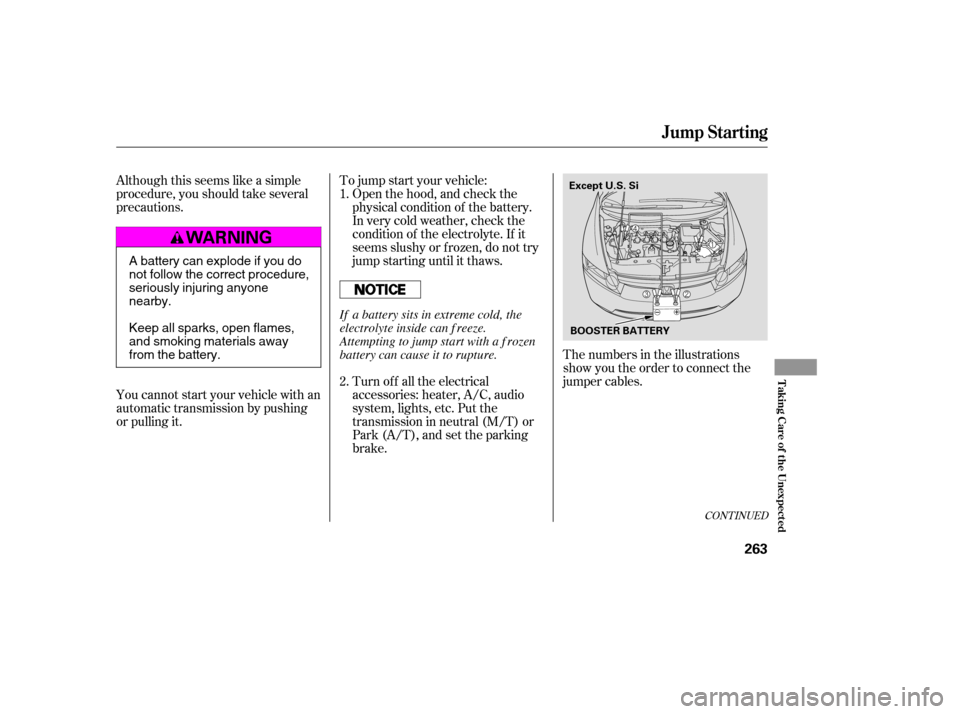Page 239 of 304
Open the trunk.
Remove the socket by turning it
one-quarter turn counterclockwise.
Pull the bulb straight out of its
socket. Push the new bulb straight
into the socket until it bottoms.
Reinstall the socket into the light
assembly by turning it clockwise
until it locks. Put the f asteners into the holes on
the side of the trunk lining.
Reinstall the screws.
Reinstall the trunk lining. Make
sure it is installed under the edge
of the trunk seal.
Test the lights to make sure the
new bulb is working.
Remove the screw from the center
of each f astener on the trunk lid
trim. Pull the trim back.
1. 2.
4. 5. 6. 7. 8.
3.
On LX, EX and U.S. Si models
Lights
Replacing Rear Bulbs
(in T runk L id)
240
BULBS
SOCKETS SOCKETS
BULB
BULB FASTENERS
�����—�����—�����y�
�������������y���
�(�#�����
���y���������y
Page 240 of 304
Remove the socket by turning it
one-quarter turn counterclockwise.Open the trunk, and remove the
socket f rom the light assembly by
turning it one-quarter turn counter-
clockwise.
Pull the bulb straight out of its
socket. Push the new bulb straight
into the socket until it bottoms.
Reinstall the socket. Turn it
clockwise until it locks. Make sure
the new bulb is working.
Pull the bulb straight out of its
socket. Push the new bulb straight
into the socket until it bottoms.
Insert the socket back into the
light assembly. Turn it clockwise
to lock it in place.
Test the lights to make sure the
new bulb is working.
Push the trunk lid trim back into
position.
Put the f asteners into the holes on
the trunk lid trim. Reinstall the
screws.
2.
1. 3.
4. 5.6. 7. 8.
3.
On LX, EX and U.S. Si models
Lights
Replacing a High-mount Brake
Light Bulb
Maint enance
241
BULB
SOCKET
BULB
SOCKET
�����—�����—�����y�
���������
���y���
�(�#�����
���y���������y
Page 255 of 304

Turn on the hazard warning lights,
and turn the ignition switch to the
LOCK (0) position. Have all
passengers get out of the vehicle
while you change the tire.
Park the vehicle on f irm, level, and
non-slippery ground. Put the
transmission in Park (automatic)
or reverse (manual). Apply the
parking brake.
Open the trunk. Raise the trunk
f loor by lif ting up on the back edge.
Take the tool case out of the spare
tire.
Unscrew the wing bolt, and take
the spare tire out of its well.
If you have a f lat tire while driving,
stop in a saf e place to change it.
Drive slowly along the shoulder until
you get to an exit or an area to stop
that is far away from the traffic lanes.
Thecompactsparetireissmaller
than a standard tire, and it will affect
the vehicle’s handling. Drive
cautiously when the spare is
mounted on your vehicle.
Thesizedifferencemayalsocause
damage to the dif f erential, so do not
mount the compact spare on the
f ront. If either f ront tire goes f lat,
removethereartireonthatsame
side, mount the compact spare tire
on the rear, then mount the rear tire
on the f ront.
5.
4.
3.
2.
1.
CONT INUED
On U.S. Si model only
Changing a Flat T ire
T aking Care of t he Unexpect ed
257
SPARE TIRE
TRUNK FLOOR JACK TOOL CASE
The vehicle can easily roll off
the jack, seriously injuring
anyone underneath.
Follow the directions for
changing a tire exactly, and
never get under the vehicle
when it is supported only by thejack.
�����—�����—�����y�
�������������y���
�(�#�����
���y���������y
Page 259 of 304

Diagnosing why the engine won’t
start f alls into two areas, depending
on what you hear when you turn the
ignition switch to the START (III)
position:When you turn the ignition switch to
the START (III) position, you do not
hear the normal noise of the engine
trying to start. You may hear a
clicking sound, a series of clicks, or
nothing at all. Turn the ignition switch to the
START (III) position. If the
headlights do not dim, check the
condition of the f uses. If the f uses
areOK,thereisprobably
something wrong with the
electrical circuit f or the ignition
switch or starter motor. You will
need a qualif ied technician to
determine the problem. See
on page .
If the headlights dim noticeably or
go out when you try to start the
engine, either the battery is
discharged or the connections are
corroded. Check the condition of
the battery and terminal connec-
tions (see page ). You can
then try jump starting the vehicle
f rom a booster battery (see page ).
You can hear the starter motor
operating normally, or the starter
motor sounds like it is spinning
f aster than normal, but the engine
does not start up and run.
You hear nothing, or almost
nothing. The engine’s starter
motor does not operate at all, or
operates very slowly.
Turn the ignition switch to the ON
(II) position. Turn on the
headlights, and check their
brightness. If the headlights are
very dim or do not come on at all,
the battery is discharged. Seeon page .
Check the transmission interlock.
If you have a manual transmission,
the clutch pedal must be pushed
all the way to the f loor or the
starter will not operate. With an
automatic transmission, it must be
in Park or neutral.
Check these things:
263 276
252
263
Nothing Happens or the Starter
Motor Operates Very Slowly
Emergency T owing
Jump Starting
If theEngineWon’tStart
T aking Care of t he Unexpect ed
261
�����—�����—�����y�
���������
���y���
�(�#�����
���y���������y
Page 261 of 304

Although this seems like a simple
procedure, you should take several
precautions.Open the hood, and check the
physical condition of the battery.
In very cold weather, check the
condition of the electrolyte. If it
seems slushy or f rozen, do not try
jump starting until it thaws.
You cannot start your vehicle with an
automatic transmission by pushing
or pulling it. To jump start your vehicle:
Turn of f all the electrical
accessories: heater, A/C, audio
system, lights, etc. Put the
transmission in neutral (M/T) or
Park (A/T), and set the parking
brake. The numbers in the illustrations
show you the order to connect the
jumper cables.
1. 2.
CONT INUED
Jump Start ing
T aking Care of t he Unexpect ed
263
BOOSTER BATTERY
Except U.S. Si
A battery can explode if you do
not follow the correct procedure,
seriously injuring anyonenearby.
Keep all sparks, open flames,
and smoking materials away
from the battery.
If a battery sits in extreme cold, the
electrolyte inside can f reeze.
Attempting to jump start with a f rozen
battery can cause it to rupture.
�����—�����—�����y�
�������������y���
�(�#�����
���y���������y
Page 265 of 304

Let the vehicle sit f or a minute.
Open the hood, and check the oil
level (see page ). An engine
very low on oil can lose pressure
during cornering and other driving
maneuvers.
If necessary, add oil to bring the
level back to the full mark on the
dipstick (see page ).
Start the engine, and watch the oil
pressure indicator. If it does not go
out within 10 seconds, turn of f the
engine. There is a mechanical
problem that needs to be repaired
bef ore you can continue driving
(see on page). Immediately turn of f all electrical
accessories. Try not to use other
electrically operated controls such as
the power windows. Keep the engine
running; starting the engine will
discharge the battery rapidly.
Go to a service station or garage
where you can get technical
assistance.
This indicator should never
come on when the engine is
running. If it starts f lashing or stays
on, the oil pressure has dropped very
low or lost pressure. Serious engine
damage is possible, and you should
take immediate action. If the charging system
indicator comes on brightly
when the engine is running, the
battery is not being charged.
Saf ely pull of f the road, and shut
of f the engine. Turn on the hazard
warning lights.
1. 2. 3. 4. 179
224
276
L ow Oil Pressure Indicator
Emergency T owingCharging System Indicator
L ow Oil Pressure Indicator, Charging System Indicator
T aking Care of t he Unexpect ed
267
Running the engine with low oil
pressure can cause serious mechanical
damage almost immediately. Turn of f
the engine as soon as you can saf ely get
the vehicle stopped.
�����—�����—�����y�
�������������y���
�(�#�����
���y���������y
Page 269 of 304
Turn the ignition switch to the
LOCK (0) position. Make sure the
headlights and all other
accessories are of f .
Remove the cover f rom the f use
box.Check the smaller f uses in the
under-hood f use box and all the
fuses in the interior fuse box by
pulling out each one with the f use
pullerprovidedonthebackof the
under-hood f use box cover.
Check each of the large f uses in
the under-hood f use box by
looking through the top at the wire
inside. Removing these f uses
requires a Phillips-head screw-
driver.
1. 2. 3.
4.
CONT INUED
Fuses
T aking Care of t he Unexpect ed
271
FUSE PULLER
BLOWN
FUSE
BLOWN
�����—�����—�����y�
�������������y���
�(�#�����
���y���������y
Page 280 of 304

�µ�µ�µ
�µ �µ�µ �µ �µ�µ�µ�µ�µ�µ�µ�µ�µ
�Î�Î�Î�Î�Î�Î
�µ�µ�µ�µ�µ
�Î
�Î �Î
�Î�Î �Î �Î
�Î
�Î
�Î
Specif icat ions
Technical Inf ormation
283
Air Conditioning
Fuses
Alignment
Lights Battery Tires
HFC-134a (R-134a)
14.1 15.9 oz (400 450 g)
SP-10
12 V 60 W (HB3)
7°24’1°30’
0°
0.00 in (0.0 mm)
P195/65R15 89H 0.08 in (2.0 mm)
Refrigerant type
Charge quantity
Lubricant oil type
Interior
Under-hood
Toe-in
CamberCaster
12 V
12 V
12 V
12 V
12 V
12 V
12 V
12 V
8W
5W
21 W
3CP
21 W
21/5 W
21 W
21/5 W
12 V 51 W (HB4)
12 V 2 CP
12 V 8 W
12 V 5 W P205/55R16 89H
Headlights
Front turn signal/side marker/
Parking lights
Rear turn signal lights
Stop/Taillights
Rear side marker lights
Back-up lights
Taillights
High-mount brake light
License plate lights
Ceiling light
Spotlights
Trunk light
Capacity
60 psi (420 kPa , 4.2 kgf/cm
)
30 psi (210 kPa , 2.1 kgf/cm
)
32 psi (220 kPa , 2.2 kgf/cm)
T125/70D15 95M
12 V
12 V
12 V
12 V 36 AH/5 HR
45 AH/20 HR
38 AH/5 HR
45 AH/20 HR Size
Pressure
12 V 47 AH/20 HR P215/45R17 87V
215/45R17 91W
T125/70D16 96M
32 psi (220 kPa , 2.2 kgf/cm)
29 psi (200 kPa , 2.0 kgf/cm)
See page 275 or the fuse label
attached to the inside of the fuse
box door under the steering
column.
See page 274 or the fuse box
cover.
HighLow
FrontRear
FrontRear
Front
1:2:3: LX, EX
DX, Canadian DX-G
U.S.Si(allseasontires) 4:5:6:
Except U.S. Si
Optional for U.S. Si (summer tires)
U.S. Si
U.S.
Vehicles
Canada
Vehicles Front/Rear
Spare
Front/Rear
Front Rear
Spare
3
3 3
12 4 6
1
2
5
�����—�����—�����y�
���������
���y���
�(�#�����
���y���������y